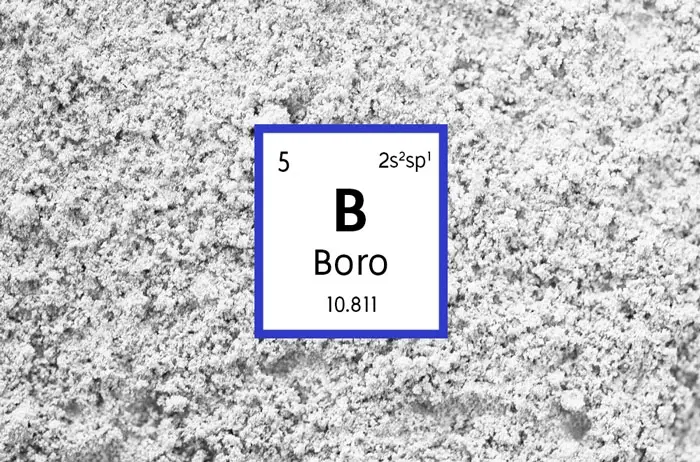
The current situation of boron compounds used as biocides for wood protection.
Insights | 12 April 2018
In recent years, many wood stains based on borate salts have come onto the market because these substances have been shown to have a preservative effect against attacks by fungi and xylophagous insects.
In this article, we will find out what boron salts are, what is new in this area and explain why we have chosen to eliminate borates from our products.
Boron salts (also called borates) are the salts of boric acids (orthoboric acid, metaboric acid and tetraboric acid).
When we speak of boric acid, we generally mean orthoboric acid, because it is the most widely used: it is a weak acid obtained by the reaction of boron-containing minerals (borate and borosilicate minerals) with sulphuric acid.
Among the most well-known and important boron salts is certainly borax, also known as sodium tetraborate decahydrate (Na2B4O7 ∙ 10 H2O). The largest mine from which this compound is extracted is located in Boron, California.
Larderello, in the province of Pisa, on the other hand, is home to Italy's most important borax industry, which extracts boron from boraciferous soffions, i.e. natural jets of water vapour in which a small percentage of boric acid is dissolved.
Boron and its compounds are used in the chemical, pharmaceutical, textile and cosmetic industries, in glass manufacture, pyrotechnics and medicine.
Substances of Very High Concern (SVHC) are all those substances that are carcinogenic, mutagenic or toxic to reproduction (CMR), persistent, bioaccumulative and toxic (PBT) or very persistent and very bioaccumulative (vPvB). More generally, these are substances for which there is scientific evidence of serious effects on human health and/or the environment.
What is the process for these substances?
The first ECHA recommendation came out in June 2009, while the latest recommendation (the eighth) was published in February 2018.
In 2015, ECHA published its sixth recommendation for the prioritisation of 15 new SVHC substances, including boric acid and certain borates (disodium tetraborate anhydrous and disodium tetraborate heptaoxide, hydrate) used in various industries, such as ceramics and glass, paints, adhesives and metallurgy. The recommendation was made because these boric substances have been classified as toxic to reproduction and are therefore candidates to enter the authorisation process to be produced, placed on the market and used. To date, manufacturers and suppliers of such substances or mixtures are only obliged to communicate specific hazard information, but have no limits or bans on their production, import or use.
Some boron compounds have been used for many years as biocides to protect wood from fungi and xylophagous insects. In addition, they can also act as flame retardants in the event of a fire: boron vitrifies at high temperatures, thus protecting wood from combustion.
For the salts to be effective, large quantities must generally be applied so that these compounds are absorbed by the wood fibre. This is why autoclave impregnation is one of the best treatment techniques.
It must be borne in mind that the effectiveness of such a biocide treatment decreases on wood exposed outdoors, as rainwater can wash the product away.
Biocidal products are regulated by the BPR (Biocidal Products Regulation) No. 528/2012 and some boron compounds have already been included in the list of biocidal active substances. This implies that such compounds, if they are included in products claiming biocidal action, must mandatorily go through the authorisation process, as we explained in this article on biocidal regulation.
Here is the list of boron compounds included in the positive list of biocidal active substances approved by the European Union:
Although the boron salts contained in Lignum P-501 (SB) are not included in the Candidate List of SVHC substances, we considered it appropriate to remove them from the product formulation, as a precautionary measure, both for our company employees and end users.
For this reason, we have removed the wording (SB) from the product name, which is now simply called Lignum P-501.
In order to offer a wood stain with very similar characteristics to Lignum P-501, but which also has a biocidal action against fungi, bacteria and xylophagous insects, we decided to create a new product: Lignum P-9000.
Its preservative action comes from the synergy of several active ingredients already included in the list of substances approved or in the process of being approved, according to Regulation No. 528/2012.
Lignum P-9000 is a product for free sale and is suitable for the treatment of wood in use classes 1 and 2 (references UNI EN 335-1:2013). For more information see its product sheet!
Did you find this article interesting? Share it on social media!
Are you convinced by our products?
Buy online.
Convenience and service always guaranteed




Join our community of professionals!
Receive previews of our insights and promotions
Viale Grazia Cavanna, 3 - Località SISSA
43018 | SISSA TRECASALI (PR) ITALY

Do you need support?
